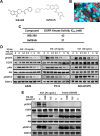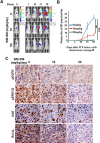Inhibition of non-small cell lung cancer (NSCLC) growth by a novel small molecular inhibitor of EGFR
- PMID: 25730907
- PMCID: PMC4466647
- DOI: 10.18632/oncotarget.3155
Inhibition of non-small cell lung cancer (NSCLC) growth by a novel small molecular inhibitor of EGFR
Abstract
The epidermal growth factor receptor (EGFR) is a therapeutic target (oncotarget) in NSCLC. Using in vitro EGFR kinase activity system, we identified a novel small molecule, WB-308, as an inhibitor of EGFR. WB-308 decreased NSCLC cell proliferation and colony formation, by causing G2/M arrest and apoptosis. Furthermore, WB-308 inhibited the engraft tumor growths in two animal models in vivo (lung orthotopic transplantation model and patient-derived engraft mouse model). WB-308 impaired the phosphorylation of EGFR, AKT, and ERK1/2 protein. WB-308 was less cytotoxic than Gefitinib. Our study suggests that WB-308 is a novel EGFR-TKI and may be considered to substitute for Gefitinib in clinical therapy for NSCLC.
Keywords: EGFR; NSCLC; TKIs; tumor growth.
Conflict of interest statement
The authors declare no competing financial interests.
Figures







Similar articles
-
Notch-1 contributes to epidermal growth factor receptor tyrosine kinase inhibitor acquired resistance in non-small cell lung cancer in vitro and in vivo.Eur J Cancer. 2013 Nov;49(16):3559-72. doi: 10.1016/j.ejca.2013.07.007. Epub 2013 Aug 2. Eur J Cancer. 2013. PMID: 23916913
-
Apatinib enhances antitumour activity of EGFR-TKIs in non-small cell lung cancer with EGFR-TKI resistance.Eur J Cancer. 2017 Oct;84:184-192. doi: 10.1016/j.ejca.2017.07.037. Epub 2017 Aug 17. Eur J Cancer. 2017. PMID: 28822888
-
244-MPT overcomes gefitinib resistance in non-small cell lung cancer cells.Oncotarget. 2015 Dec 29;6(42):44274-88. doi: 10.18632/oncotarget.6236. Oncotarget. 2015. PMID: 26517520 Free PMC article.
-
Implications of MicroRNAs in the Treatment of Gefitinib-Resistant Non-Small Cell Lung Cancer.Int J Mol Sci. 2016 Feb 15;17(2):237. doi: 10.3390/ijms17020237. Int J Mol Sci. 2016. PMID: 26891293 Free PMC article. Review.
-
[Progress of c-MET Signaling Pathway and TKIs in Non-small Cell Lung Cancer].Zhongguo Fei Ai Za Zhi. 2017 Apr 20;20(4):287-292. doi: 10.3779/j.issn.1009-3419.2017.04.10. Zhongguo Fei Ai Za Zhi. 2017. PMID: 28442019 Free PMC article. Review. Chinese.
Cited by
-
MicroRNA-370 inhibits the growth and metastasis of lung cancer by down-regulating epidermal growth factor receptor expression.Oncotarget. 2017 Oct 4;8(50):88139-88151. doi: 10.18632/oncotarget.21537. eCollection 2017 Oct 20. Oncotarget. 2017. PMID: 29152147 Free PMC article.
-
JQ1 synergizes with the Bcl-2 inhibitor ABT-263 against MYCN-amplified small cell lung cancer.Oncotarget. 2017 Sep 21;8(49):86312-86324. doi: 10.18632/oncotarget.21146. eCollection 2017 Oct 17. Oncotarget. 2017. PMID: 29156797 Free PMC article.
-
A novel anticancer agent SNG1153 inhibits growth of lung cancer stem/progenitor cells.Oncotarget. 2016 Jul 19;7(29):45158-45170. doi: 10.18632/oncotarget.9783. Oncotarget. 2016. PMID: 27281614 Free PMC article.
-
Simultaneous Detection of the T790M and L858R Mutations in the EGFR Gene by Oligoribonucleotide Interference-PCR.Int J Mol Sci. 2019 Aug 17;20(16):4020. doi: 10.3390/ijms20164020. Int J Mol Sci. 2019. PMID: 31426517 Free PMC article.
-
Potential Therapeutic Use of Aptamers against HAT1 in Lung Cancer.Cancers (Basel). 2022 Dec 30;15(1):227. doi: 10.3390/cancers15010227. Cancers (Basel). 2022. PMID: 36612223 Free PMC article.
References
-
- Juergens R, Brahmer J. Targeting the epidermal growth factor receptor in non-small-cell lung cancer: who, which, when, and how? Curr Oncol Rep. 2007;9:255–264. - PubMed
-
- Smith RA, Brooks D, Cokkinides V, Saslow D, Brawley OW. Cancer screening in the United States, a review of current American Cancer Society guidelines, current issues in cancer screening, and new guidance on cervical cancer screening and lung cancer screening. CA Cancer J Clin. 2013;63:88–105. - PubMed
-
- Marshall HM, Leong SC, Bowman RV, Yang IA, Fong KM. The science behind the 7th edition tumour, node, metastasis staging system for lung cancer. Respirology. 2012;17:247–260. - PubMed
Publication types
MeSH terms
Substances
LinkOut - more resources
Full Text Sources
Other Literature Sources
Medical
Research Materials
Miscellaneous

